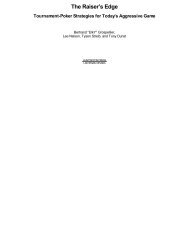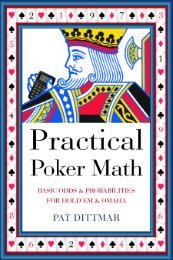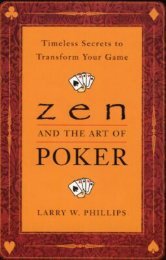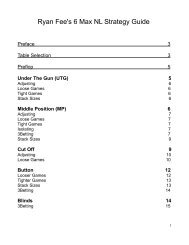You also want an ePaper? Increase the reach of your titles
YUMPU automatically turns print PDFs into web optimized ePapers that Google loves.
Aggression<br />
Bluffing<br />
We're going to begin examining the math behind aggression in<br />
poker. We'll start with bluffing. The ability to bluff is a big part<br />
of poker. We can use it to exploit opponents and also to help us<br />
get value from our strong hands when playing against good,<br />
observant opponents. Some have said "Bluff just enough to get<br />
the job done." However, I've found this to be too narrow in<br />
playing poker. How do you decide whether a bluff is a<br />
profitable play or not?<br />
You may remember the equation x / (x + y) where x is the size of<br />
the bet we must call, and y is the size of the pot before our call.<br />
Well, the equation to determine how often our opponent must<br />
fold when we bluff is the same, except now x is the amount of<br />
our bet instead of the amount of our call. So let’s say the pot is<br />
$10, and we bluff the pot with a $10 bet.<br />
x = $10<br />
y = $10<br />
10 / (10 + 10)<br />
10 / 20 = 0.50<br />
So, our opponent must fold more than 50% of the time to have a<br />
+EV bluff. Now, let’s take this scenario to the next step. Our<br />
opponent is deciding whether or not to call our pot-size bet. He<br />
again uses the x / (x + y) method and comes up with the need to<br />
be good 33% of the time.<br />
93









